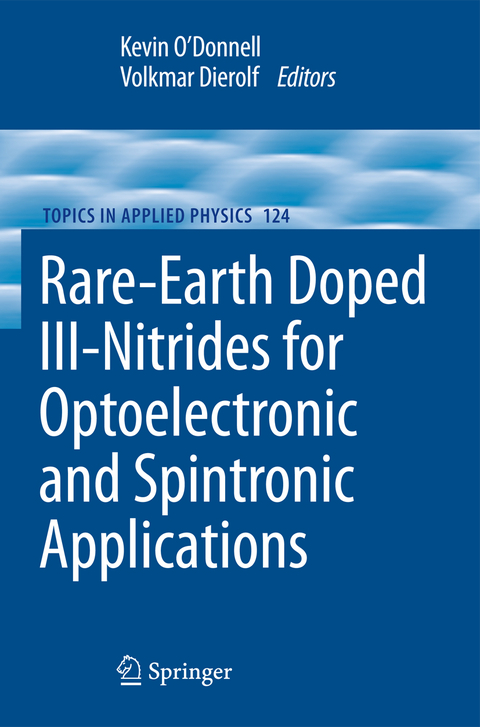
Rare-Earth Doped III-Nitrides for Optoelectronic and Spintronic Applications
Seiten
2014
Springer (Verlag)
978-94-017-8472-6 (ISBN)
Springer (Verlag)
978-94-017-8472-6 (ISBN)
This book summarises recent progress in the science and technology of rare-earth doped nitrides, providing a snapshot of the field at a critical point in its development. It is the first book on rare-earth doped III-Nitrides and semiconductors.
It has been noted several times previously that the Rare Earths (RE), a sequence of elements with atomic numbers in the range from 58 (Ce) to 71 (Lu), are neither earths nor particularly rare. They are metals, whose ores are often found together with oxides of the "alkaline earths" (Ca, Mg), staples of the building industry, th while Cerium, for example, is the 25 most abundant element in the Earth's crust. However, the chemical similarity of all REs to each other and to Lanthanum, reflected in their alternative descriptor, Lanthanoids, made extraction of the separate elements difficult until technical advances in the 1960s kick-started the modern era of RE science. The most widespread commercial use of RE metals at present is in the prod- tion of super-strong permanent magnets, containing Neodymium: check your refrigerator door for an example. RE ferromagnetism arises from the angular momentum of electrons in partially filled 4f atomic shells. In chemical compounds of RE with non-metals, the 4f shell is surrounded by filled 5s and 5p orbitals, 1 2 while bonding involves the outerlying 5d and 6s electrons, resulting (usually) in 3+ 3+ a RE ion that is chemically similar to La .
(RE may also be found in a divalent charge state, with an 'extra' electron in the 5d shell. ) Hence the sequence of 3+ 3+ trivalent ions from Ce to Yb is characterised by a 4f shell occupation that rises from 1 to 13 electrons.
It has been noted several times previously that the Rare Earths (RE), a sequence of elements with atomic numbers in the range from 58 (Ce) to 71 (Lu), are neither earths nor particularly rare. They are metals, whose ores are often found together with oxides of the "alkaline earths" (Ca, Mg), staples of the building industry, th while Cerium, for example, is the 25 most abundant element in the Earth's crust. However, the chemical similarity of all REs to each other and to Lanthanum, reflected in their alternative descriptor, Lanthanoids, made extraction of the separate elements difficult until technical advances in the 1960s kick-started the modern era of RE science. The most widespread commercial use of RE metals at present is in the prod- tion of super-strong permanent magnets, containing Neodymium: check your refrigerator door for an example. RE ferromagnetism arises from the angular momentum of electrons in partially filled 4f atomic shells. In chemical compounds of RE with non-metals, the 4f shell is surrounded by filled 5s and 5p orbitals, 1 2 while bonding involves the outerlying 5d and 6s electrons, resulting (usually) in 3+ 3+ a RE ion that is chemically similar to La .
(RE may also be found in a divalent charge state, with an 'extra' electron in the 5d shell. ) Hence the sequence of 3+ 3+ trivalent ions from Ce to Yb is characterised by a 4f shell occupation that rises from 1 to 13 electrons.
Theoretical Modelling of Rare Earth Dopants in GaN.- RE Implantation and Annealing of III-Nitrides.- Lattice Location of RE Impurities in IIINitrides.- Electroluminescent Devices Using RE-Doped III-Nitrides.- Er-Doped GaN and InxGa1-xN for Optical Communications.- Rare-Earth-Doped GaN Quantum Dot.- Visible Luminescent RE-doped GaN, AlGaN and AlInN.- Combined Excitation Emission Spectroscopy (CEES) of RE Ions in Gallium Nitride.- Excitation Mechanisms of RE Ions in Semiconductors.- High-Temperature Ferromagnetism in the Super-Dilute Magnetic Semiconductor GaN:Gd.- Summary and Prospects for Future Work.
| Erscheint lt. Verlag | 2.11.2014 |
|---|---|
| Reihe/Serie | Topics in Applied Physics ; 124 |
| Zusatzinfo | XVI, 355 p. |
| Verlagsort | Dordrecht |
| Sprache | englisch |
| Maße | 155 x 235 mm |
| Themenwelt | Naturwissenschaften ► Physik / Astronomie ► Optik |
| Naturwissenschaften ► Physik / Astronomie ► Quantenphysik | |
| Technik ► Elektrotechnik / Energietechnik | |
| Technik ► Maschinenbau | |
| ISBN-10 | 94-017-8472-8 / 9401784728 |
| ISBN-13 | 978-94-017-8472-6 / 9789401784726 |
| Zustand | Neuware |
| Haben Sie eine Frage zum Produkt? |
Mehr entdecken
aus dem Bereich
aus dem Bereich
Grundlagen - Verfahren - Anwendungen - Beispiele
Buch | Hardcover (2022)
Hanser, Carl (Verlag)
49,99 €
Grundlagen und Anwendungen
Buch | Hardcover (2023)
Hanser, Carl (Verlag)
59,99 €


